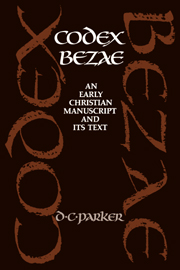Book contents
- Front Matter
- Contents
- List of illustrations
- Preface
- Abbreviations and textual conventions
- Introduction
- PART I The palaeography
- PART II The scribe and the tradition
- PART III The correctors
- Chapter Nine The corrections
- Chapter Ten The supplementary leaves
- Chapter Eleven The development of the corrected text
- PART IV The bilingual tradition
- Part V Text and codex
- Appendices
- Plates
- Notes on the plates
- Indexes
Chapter Nine - The corrections
Published online by Cambridge University Press: 09 November 2009
- Front Matter
- Contents
- List of illustrations
- Preface
- Abbreviations and textual conventions
- Introduction
- PART I The palaeography
- PART II The scribe and the tradition
- PART III The correctors
- Chapter Nine The corrections
- Chapter Ten The supplementary leaves
- Chapter Eleven The development of the corrected text
- PART IV The bilingual tradition
- Part V Text and codex
- Appendices
- Plates
- Notes on the plates
- Indexes
Summary
Observation of the correctors shows us a variety of ways in which a bilingual tradition was treated over several centuries. This can give us an insight into the transmission of the tradition which lies behind D. In studying the correctors, we are observing the bilingual text developing. We are also able to find indications of the early use and history of the manuscript. Apart from this, it is to be hoped that some more generally applicable insights into the correcting of manuscripts may be gained.
We shall therefore be examining three main questions: what kind of alterations each corrector made; how these affected the relationship between the columns; and what other texts were known to him.
With regard to the relationship between the columns, the received wisdom is that the column in which a corrector wrote was the one that concerned him. This is not necessarily the case. If, for example, all his corrections were to the Greek column, but invariably brought it into agreement with the Latin where formerly they had disagreed, then it could be argued that his interest was in the latter and in justifying its text. This instance is in fact hypothetical. But we cannot follow Bonifatius Fischer in dividing the early history of D into three stages. According to him the first, including its copying and Corrector G, was bilingual; the second, lasting till 800, was purely Greek; and the third purely Latin (p. 40).
Information
- Type
- Chapter
- Information
- Codex BezaeAn Early Christian Manuscript and its Text, pp. 123 - 165Publisher: Cambridge University PressPrint publication year: 1992
